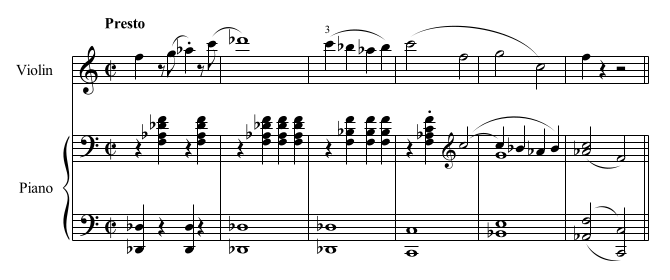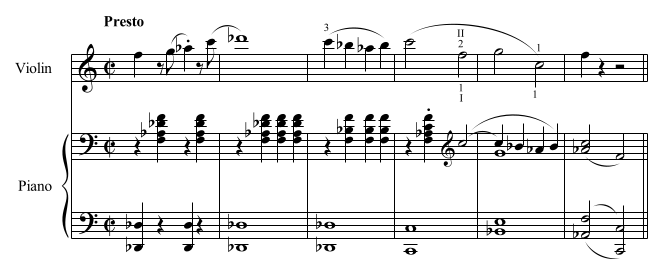Fingering choices when playing a perfect 5th
Usually, when there is a perfect 5th like this:

We use the same finger to play both of the notes as you see below.

However, there are times we should use two different fingers to play a perfect 5th like so.

In this article, we will explore possibilities of applying different fingerings to play perfect 5ths.
First, the basics - cover both notes with one finger
To make the fingerings more organized and effective, we put one finger down on both strings at once when we play a perfect 5th with two adjacent strings. This technique makes your playing cleaner when you are playing a fast passage. You can play quicker and more in tune by doing it.
If we don't have to cover both strings at once, we play the perfect 5th simply by moving the same finger from one string to the next.
Playing a perfect 5th smoothly
Playing a 5th with a same finger works well, but it often becomes a problem when you need to move seamlessly from one to the other note in a singing melody.
It is not the easiest thing to cover two strings with one finger, especially if your fingers are thin. It is difficult to make a smooth note change. Your tone could suffer because you cannot cover both strings entirely with one finger. It becomes even more difficult when you want to keep vibrating continuously from one to the other note.
If you don't cover both strings at once, then you would have to move the same finger very quickly to the next string. However, because you are lifting your finger slightly to get to the next string, if is difficult to make a truly smooth transition between the notes.
In an occasion like that, try using two different fingers to play the 5th. You might find it so much easier and smoother to go from one note to the next. Here are some examples.
Examples

In this first example, the E♭-D-C-B♭ makes up a bass line. These notes need extra care in order to bring out the line. You want to make sure that your finger is fully depressing the string, and some vibrato will enhance the tone.
You could play the 5ths with the 1st finger. However, using the 2nd finger for the 2nd notes of each 5th can make the transition more seamless, especially if you want to vibrate on these notes

There are several things we need to consider in this example. This passage requires a quick note change. It's a singing passage so we would be continuously vibrating both notes. Also, there is a slur so the transition between the two notes need to be smooth.
The most conventional fingering would be to use the 3rd finger for both C♭ and F♭. However, you might find it difficult to change the notes quickly and smoothly while you are still singing both notes. Instead, try using the 2nd finger for the C♭, then use the 3rd finger for the F♭. Make sure your fingers are loose when you switch to the F♭. I think you will find the transition much smoother. It is easier to keep vibrating as well.

There is a 5th from the 4th to the 5th measure. By using two different fingers, you can make a smoother transition between the 5th. It will also make it easier to continue the vibrato in between the notes.

In this example of a Brahms' symphony, there is a perfect 5th from the 4th to the 5th measure. This is a very delicate phrase, and the transition between the two notes needs to be absolutely smooth.

This is an example from near the end of "Also Sprach Zarathustra". This passage calls for a smooth and well connected note changes. In the 4th measure of the example, it helps the perfect 5th move smoothly from one to the next by using 3 for the E, and then switch to the 2nd finger for the B.

There are perfect 5ths in measure 4 and 5. We could use the same finger to play the 5ths, but you might find that it is difficult to maintain good tone while making the transition of the two notes smooth. Again, try using different fingers instead as shown below.

The top fingerings, we use the 3rd finger on the E string for the 'C', then the 2nd finger on the A string for the 'F'. The bottom fingerings, we use the 2nd finger on the E string for the 'G', then the 1st finger on the A string for the 'C'. Both fingerings will give you a smooth transition between the two notes, and you can fully vibrate both notes even if you have thin fingers.
Study each case
Using two different fingers to play a 5th proves to be most useful when you need to play the two notes smoothly and seamlessly in a singing passage.
When applied appropriately, this technique works wonders. However, there are many instances where you should simply use the same finger. Each case is different, and each player's needs are different. There is no one correct answer to it. Just like any other technique and interpretation, we need to examine various options to determine what is best. The more you think about it, the better violinist you will become!